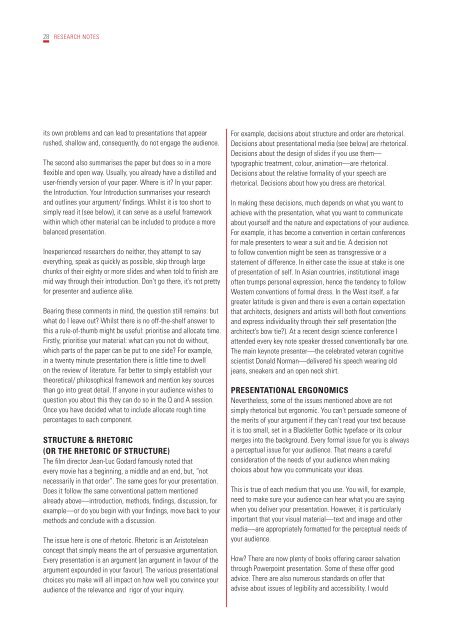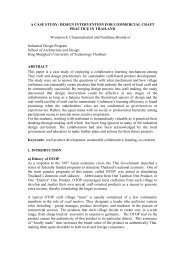soa+d research manual - School of Architecture and Design, KMUTT
soa+d research manual - School of Architecture and Design, KMUTT
soa+d research manual - School of Architecture and Design, KMUTT
Create successful ePaper yourself
Turn your PDF publications into a flip-book with our unique Google optimized e-Paper software.
28 REsEARch NOTEs<br />
its own problems <strong>and</strong> can lead to presentations that appear<br />
rushed, shallow <strong>and</strong>, consequently, do not engage the audience.<br />
The second also summarises the paper but does so in a more<br />
flexible <strong>and</strong> open way. usually, you already have a distilled <strong>and</strong><br />
user-friendly version <strong>of</strong> your paper. Where is it? in your paper:<br />
the introduction. your introduction summarises your <strong>research</strong><br />
<strong>and</strong> outlines your argument/ findings. Whilst it is too short to<br />
simply read it (see below), it can serve as a useful framework<br />
within which other material can be included to produce a more<br />
balanced presentation.<br />
inexperienced <strong>research</strong>ers do neither, they attempt to say<br />
everything, speak as quickly as possible, skip through large<br />
chunks <strong>of</strong> their eighty or more slides <strong>and</strong> when told to finish are<br />
mid way through their introduction. Don’t go there, it’s not pretty<br />
for presenter <strong>and</strong> audience alike.<br />
bearing these comments in mind, the question still remains: but<br />
what do i leave out? Whilst there is no <strong>of</strong>f-the-shelf answer to<br />
this a rule-<strong>of</strong>-thumb might be useful: prioritise <strong>and</strong> allocate time.<br />
firstly, prioritise your material: what can you not do without,<br />
which parts <strong>of</strong> the paper can be put to one side? for example,<br />
in a twenty minute presentation there is little time to dwell<br />
on the review <strong>of</strong> literature. far better to simply establish your<br />
theoretical/ philosophical framework <strong>and</strong> mention key sources<br />
than go into great detail. if anyone in your audience wishes to<br />
question you about this they can do so in the Q <strong>and</strong> A session.<br />
Once you have decided what to include allocate rough time<br />
percentages to each component.<br />
STRUCTURE & RHETORIC<br />
(OR THE RHETORIC OF STRUCTURE)<br />
The film director jean-luc godard famously noted that<br />
every movie has a beginning, a middle <strong>and</strong> an end, but, “not<br />
necessarily in that order”. The same goes for your presentation.<br />
Does it follow the same conventional pattern mentioned<br />
already above—introduction, methods, findings, discussion, for<br />
example—or do you begin with your findings, move back to your<br />
methods <strong>and</strong> conclude with a discussion.<br />
The issue here is one <strong>of</strong> rhetoric. Rhetoric is an Aristotelean<br />
concept that simply means the art <strong>of</strong> persuasive argumentation.<br />
Every presentation is an argument (an argument in favour <strong>of</strong> the<br />
argument expounded in your favour). The various presentational<br />
choices you make will all impact on how well you convince your<br />
audience <strong>of</strong> the relevance <strong>and</strong> rigor <strong>of</strong> your inquiry.<br />
for example, decisions about structure <strong>and</strong> order are rhetorical.<br />
Decisions about presentational media (see below) are rhetorical.<br />
Decisions about the design <strong>of</strong> slides if you use them—<br />
typographic treatment, colour, animation—are rhetorical.<br />
Decisions about the relative formality <strong>of</strong> your speech are<br />
rhetorical. Decisions about how you dress are rhetorical.<br />
in making these decisions, much depends on what you want to<br />
achieve with the presentation, what you want to communicate<br />
about yourself <strong>and</strong> the nature <strong>and</strong> expectations <strong>of</strong> your audience.<br />
for example, it has become a convention in certain conferences<br />
for male presenters to wear a suit <strong>and</strong> tie. A decision not<br />
to follow convention might be seen as transgressive or a<br />
statement <strong>of</strong> difference. in either case the issue at stake is one<br />
<strong>of</strong> presentation <strong>of</strong> self. in Asian countries, institutional image<br />
<strong>of</strong>ten trumps personal expression, hence the tendency to follow<br />
Western conventions <strong>of</strong> formal dress. in the West itself, a far<br />
greater latitude is given <strong>and</strong> there is even a certain expectation<br />
that architects, designers <strong>and</strong> artists will both flout conventions<br />
<strong>and</strong> express individuality through their self presentation (the<br />
architect’s bow tie?). At a recent design science conference i<br />
attended every key note speaker dressed conventionally bar one.<br />
The main keynote presenter—the celebrated veteran cognitive<br />
scientist Donald Norman—delivered his speech wearing old<br />
jeans, sneakers <strong>and</strong> an open neck shirt.<br />
PRESENTATIONAL ERGONOMICS<br />
Nevertheless, some <strong>of</strong> the issues mentioned above are not<br />
simply rhetorical but ergonomic. you can’t persuade someone <strong>of</strong><br />
the merits <strong>of</strong> your argument if they can’t read your text because<br />
it is too small, set in a blackletter gothic typeface or its colour<br />
merges into the background. Every formal issue for you is always<br />
a perceptual issue for your audience. That means a careful<br />
consideration <strong>of</strong> the needs <strong>of</strong> your audience when making<br />
choices about how you communicate your ideas.<br />
This is true <strong>of</strong> each medium that you use. you will, for example,<br />
need to make sure your audience can hear what you are saying<br />
when you deliver your presentation. however, it is particularly<br />
important that your visual material—text <strong>and</strong> image <strong>and</strong> other<br />
media—are appropriately formatted for the perceptual needs <strong>of</strong><br />
your audience.<br />
how? There are now plenty <strong>of</strong> books <strong>of</strong>fering career salvation<br />
through Powerpoint presentation. some <strong>of</strong> these <strong>of</strong>fer good<br />
advice. There are also numerous st<strong>and</strong>ards on <strong>of</strong>fer that<br />
advise about issues <strong>of</strong> legibility <strong>and</strong> accessibility. i would



